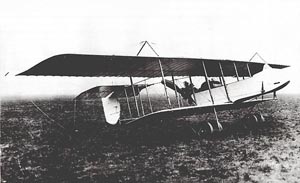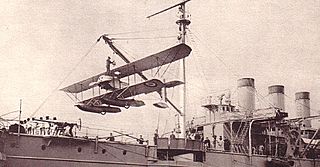The Bristol Biplane Type 'T', sometimes called the Challenger-Dickson Biplane, was a derivative of the Bristol Boxkite. It was built in 1911 by the British and Colonial Aeroplane Company and was designed as a cross-country racing aircraft for Maurice Tabuteau.

The Blériot 165 was a French airliner of the 1920s. It was a four-engined biplane, a final development in the family of designs that began with the Blériot 115. Two were built for Air Union to replace the Farman Goliath on their Paris–London route and were christened Leonardo da Vinci and Octave Chanute. The airline found that it preferred the Lioré et Olivier LeO 21s that it had ordered alongside this aircraft, meaning that no further examples were produced.

The Farman F.120 and its derivatives were a family of multi-engine airliners and bombers of the 1920s built by the Farman Aviation Works in France.

The Farman F.70 was a 1920s French passenger and mail transport aircraft designed and built by the Farman Aviation Works. It was a smaller counterpart to the company's popular F.60 Goliath. The F.70 was an unequal-span two-bay biplane with a wooden fuselage and was powered by a Renault 12Fe piston engine. The pilot was seated in an open cockpit behind the nose-mounted engine. Behind the open cockpit was a cabin for four passengers or freight.

The Farman F.300 and F.310 were airliners built in France in the early 1930s. They were high-wing strut braced monoplanes with fixed tailskid undercarriage with a trimotor layout popular with several manufacturers of the time. The cockpit and passenger compartment were fully enclosed. Most saw service in Farman's own airline, whose twelve F.300 variants made up half its fleet in 1931.

The Farman HF.20 and its derivatives were a family of reconnaissance aircraft produced in France shortly before and during the First World War. It was a refined version of the Farman MF.11 "Shorthorn" that did away with the type's distinctive landing skids, and incorporated design features from Henri Farman's designs. It entered service with the French, Belgian and Serbian armies in 1913, and with the British RFC and RNAS shortly after the outbreak of war. The type was also licence-built in the UK by Airco and Grahame-White.

The Farman NC.470 was a French twin-engined floatplane designed as a crew trainer for the French Navy. It was used in small numbers for both its intended role as a trainer and as a coastal reconnaissance aircraft at the start of World War II.

The Caudron J Marine was an amphibious, two-seat, biplane equipped with floats and wheels, similar to the earlier Caudron J floatplane.
The Farman F.150 was a 1920s French twin-engined biplane designed by Farman as a day bomber.
The Farman F.30A C2 was a two-seat biplane designed as a fighter in France in 1916 and powered by a single, water-cooled radial engine. It showed poor flight characteristics and only one was built, though it was modified twice. It should not be confused with the similarly named Henry Farman HF.30 of 1915, a completely different aircraft which was used in large numbers by the Imperial Russian Air Service.

The Short S.36 was a British two-seat tractor biplane, built by Short Brothers for Francis McClean in 1911. It was later developed into the Short S.41 and Short S.45, which were the first of a long series of similar aircraft built for the RNAS and RFC.

The Sikorsky S-7 was a Russian single engine experimental prototype aircraft built by the Russian Baltic Railroad Car Works shortly after Igor Sikorsky became chief engineer of the aircraft manufacturing division.

The Sikorsky S-11 Polukroogly was a Russian single engine prototype reconnaissance aircraft completed in July 1913 by the Russian Baltic Railroad Car Works while Igor Sikorsky was the chief engineer of the aircraft manufacturing division.

The Farman HF.6 was a reconnaissance aircraft built in France shortly before the First World War.
The Farman HF.10 was a reconnaissance aircraft built in France shortly before the First World War.
The Farman HF.7 was a reconnaissance aircraft built in France shortly before the First World War.
The Maurice Farman MF.16 was a French reconnaissance aircraft developed before World War I by the Farman Aviation Works.
The Farman HF.16 was a reconnaissance aircraft built in France shortly before the First World War.
The Henry Farman HF.19 was a French reconnaissance seaplane developed by Henry Farman before World War I. As a floatplane, it used floats for take-off and landing on water.
The Goupy Type B was a staggered biplane designed by Ambroise Goupy in the early 1910s.










